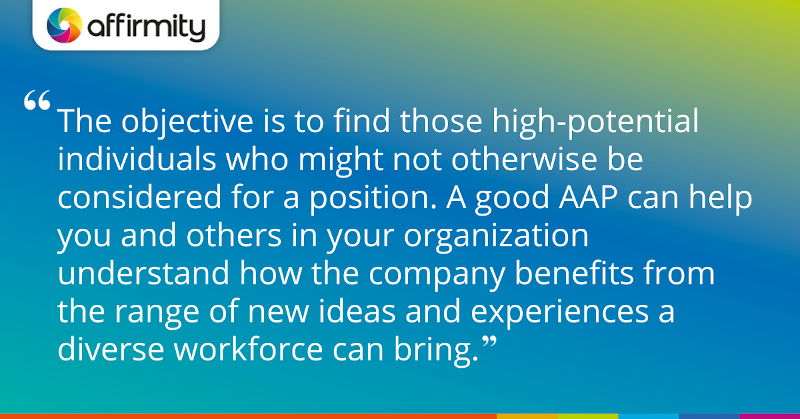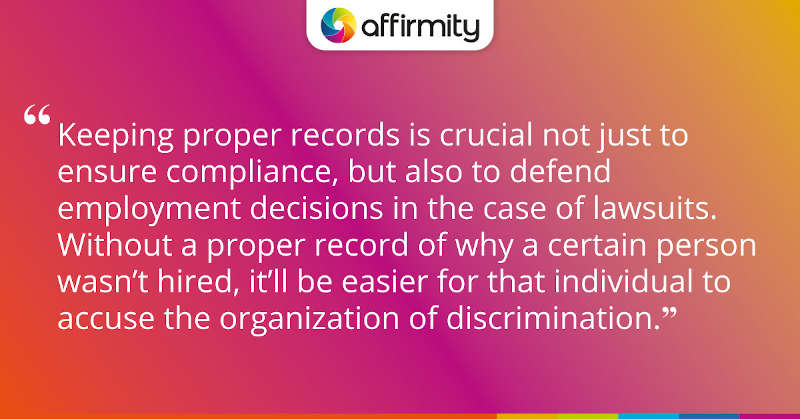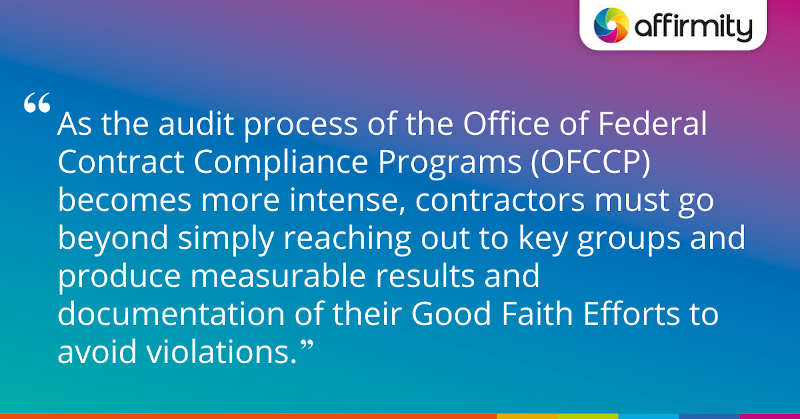Good Faith Efforts (GFEs) are a critical component of the Affirmative Action Plans required by the US government for federal contractors. In this extract from the guide, The Why, How, and What of Good Faith Efforts, we examine why they are so important—from the OFCCP’s requirements to the risks of non-compliance.
Every organization wants to identify and hire qualified individuals who’ll impact business results on day one. However, there are millions of talented candidates in the workforce who, for a number of reasons, are unable to connect with employers and find fulfilling careers.
These individuals typically fall into one or more of four groups recognized as facing significant barriers to employment:
- Women
- Minorities
- Veterans
- Individuals with disabilities.
The reasons for their struggle in finding employment vary, and organizations must adapt their recruiting strategies to reach them, or risk missing the opportunity to hire employees with valuable intellectual, technical, and emotional skills.
To avoid discrimination and afford all applicants equal opportunities, the US government requires that federal contractors and subcontractors take affirmative action to attract, engage, and hire individuals without regard to race, color, religion, sex, sexual orientation, gender identity, national origin, disability, or veteran status.
One element of these Affirmative Action Plans (AAPs) that will immediately impact your recruiting is a Good Faith Efforts (GFEs) program.
Why GFEs Are Important: A Programmatic Approach to Good Faith Efforts
For federal contractors, a Good Faith Efforts program supports their compulsory AAP requirements. They can also protect companies who aren’t federal contractors against accusations of discriminatory hiring processes and ensure your company benefits from a diverse workforce.
Put simply, progressive organizations gain a competitive advantage when they invest in “diversity of thought” for their workforce.

At its core, a Good Faith Efforts program defines quantitative goals based on the availability of targeted qualified applicants or current employees. In this way, companies can prevent discrimination in hiring and talent management processes, and provide all individuals with an equal opportunity to showcase their skills and competencies and find employment.
It should be noted that affirmative action efforts, including Good Faith Efforts, are not about setting aside certain positions for a specific group or working to meet hiring quotas. Rather, the objective is to find those high-potential individuals who might not otherwise be considered for a position. A good AAP can help you and others in your organization understand how the company benefits from the range of new ideas and experiences a diverse workforce can bring.
Good Faith Efforts to hire from the four key groups, and D&I in general, are currently in a tenuous position in terms of organizational priority. History has shown that D&I recedes as a priority in a crisis—something that McKinsey noted with trepidation early in the COVID-19 pandemic. Though any deprioritization of D&I in 2020 was undoubtedly offset by the George Floyd protests that erupted a matter of days after McKinsey’s article, it remains to be seen whether organizations will follow through.
Regardless, organizations that develop robust, effective Good Faith Efforts programs, can ensure they eradicate discrimination and hire high-performing candidates, regardless of their background or unique personal circumstances. Whether GFEs are required or not, they help organizations achieve all this through a combination of outreach, recruiting activities, and training.
A USEFUL REMINDER | ‘5 Ways to Prepare for Your 2021 Affirmative Action and Diversity Initiatives‘
OFCCP Requirements for Good Faith Efforts
Federal contractors must remember that a Good Faith Efforts program is required as part of their affirmative action program. As the audit process of the Office of Federal Contract Compliance Programs (OFCCP) becomes more intense, contractors must go beyond simply reaching out to key groups and produce measurable results and documentation of their Good Faith Efforts to avoid violations.

Eliminating barriers in recruitment and hiring is a consistent pillar of the strategic efforts advised in past EEOC Strategic Enforcement Plans (including the 2018-2022 edition) and is likely to continue to be retained for years to come.
There was a fall in the total number of receipts and resolutions during the previous administration: a decrease of 18.7% in terms of receipts and 12.8% in terms of resolutions between FY 2015 and FY 2019. It remains to be seen whether the volume of claims will return to late Obama-era levels (when EEO claims routinely rose year-on-year). Regardless, with 72,675 receipts, 80,806 resolutions, and around $385 million in total charges during FY 2019, the cost of non-compliance remains difficult to ignore.
ALSO ON THE BLOG | ‘6 Ways to Advance Your AAP Beyond Compliance‘
Tracking Good Faith Efforts
So how can you ensure that your Good Faith Efforts will guard against an OFCCP infraction? Track and record your Good Faith Efforts plan and maintain that record with the actions you take to execute on that plan.
After all, the most common OFCCP violation is the failure to keep proper records, despite the variety of recordkeeping solutions available.
Keeping proper records is crucial not just to ensure compliance, but also to defend employment decisions in the case of lawsuits. For instance, without a proper record of why a certain person wasn’t hired, it’ll be easier for that individual to accuse the organization of discrimination.

Consider the example of one federal contractor that endured compliance reviews spanning seven years. The investigation uncovered systematic discrimination against 21,635 workers who applied for entry-level positions in 15 states. Affected workers included:
- Men and women
- African-American, Caucasian, and Native American job seekers
- Job seekers of Hispanic and Asian descent.
The audit concluded with a $3 million settlement due to alleged hiring discrimination allegations and extensive violations of record-keeping requirements. As part of that settlement, the company also had to:
- Extend job offers to 1,703 of the affected workers as positions became available.
- Correct any discriminatory hiring practices.
- Develop and implement EEO training.
- Launch extensive self-monitoring measures.
- Engage an outside consultant to perform an extensive review of the company’s hiring practices.
The company also had to provide recommendations to change and improve those practices to train incumbent and future supervisors and employees and to monitor compliance with EEO laws enforced by OFCCP.
KNOW YOUR NUMBERS | ‘Do You Know Your Diversity Numbers? The Value of Intersectionality, Benchmarking, and Beyond‘
Reputational Risk and Good Faith Efforts
For companies that are unable to show proof of their Good Faith Efforts, or neglect to develop a plan in the first place, the financial impact of non-compliance is only one consideration.
Unwanted media attention for contractors and non-contractors alike who are found to have discriminatory hiring practices can damage the brand’s reputation and its ability to attract qualified new candidates, ultimately with the potential to impact the organization’s profitability. For example, in 2020 retail giant Walmart, Inc. settled an EEOC nationwide hiring discrimination case for $20 million. Similarly, in 2019, car-sharing app maker Uber paid $4.4 million to resolve sexual harassment and retaliation charges. Both cases were extensively covered in national and specialist press.
Ultimately, the exercise of creating an AAP that incorporates Good Faith Efforts can help any company achieve greater success.
Implementing and Demonstrating Good Faith Efforts: Continue Reading
Find out everything you need to know about Good Faith Efforts to build a truly audit-proof AAP in our updated Good Faith Efforts guide. The full guide covers:
- Why they are important.
- How they can be most effectively executed.
- What you need to do to prove that they have been successful.
Download your copy of the guide today.

Are you ensuring your AAPs are truly audit-ready? Contact our team for advice and solutions that will help you build watertight programs
This blog post was previously posted in 2016 and has been updated with the latest information available.
